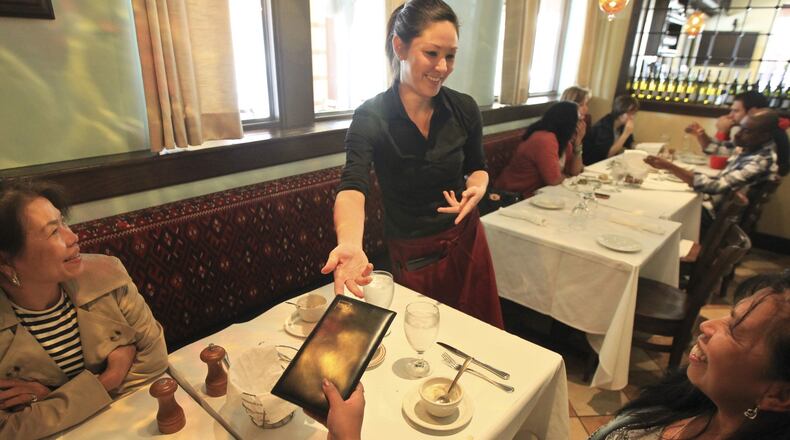How servers can increase tips, according to a researcher:
— Wear something unusual
— Introduce yourself by name
— Squat next to the table
— Touch customers
— Entertain customers
— Repeat customers’ orders
— Address customers by name
— Draw on the check
— Smile
— Write “Thank You” on the check
— Forecast good weather
— Give customers candy
Source: Research by Michael Lynn of Cornell University. Referenced at http://www.tippingresearch.com/uploads/CQ_Employee_retention_11_08.pdf
When it comes to giving tips (I mean money, not advice) I didn’t fully realize how confused I was. Then I started reporting for this piece.
In the U.S. we are going through a confounding revolution in gratuities and there’s no telling where we will end up.
Do you always tip hotel housekeeping staff? How much is right? How about giving gratuities for to-go orders at sit-down restaurants? And if you tip them, why not the 17-year-old at the McDonald’s drive-through? If I tip a bartender a couple bucks for opening a beer bottle, why not the hardware store helper who cuts plywood for me or the Kroger stocker who points out where the capers are?
Ride-hailing business Uber has introduced gratuity-free service in an industry once dominated by tip-hungry taxi drivers. On the flip side, Marriott launched a campaign last year to push its hotel customers to tip housekeeping staff, which makes me wonder if the company is paying them enough.
A scattering of New York restaurants recently nabbed attention for instituting no-tipping policies as a way to narrow the yawning divide in compensation between wait staff and hard-to-fill kitchen positions. Some menu prices will rise, as will restaurant-paid hourly wages for workers.
And Joe’s Crab Shack, which has several restaurants in metro Atlanta, announced a no-tipping-expected policy in 18 locations (none in Georgia). Starting wages for waiters will bump to $14 an hour. Menu prices will rise 12 to 15 percent, so people who tipped well in the past could end up paying less overall now.
I asked a waitress what she thought of the idea.
“That is a huge pay cut,” Candais Franklin, a waitress at the Joe’s Crab Shack in Duluth, Ga., told me.
But she said it might be good for waiters in general. By that I think she means ones who don’t hustle or didn’t learn what her first manager at an IHOP taught her: “A smile can make the difference between a $2 tip and a $10 tip.”
Relying on tips is a gamble. Servers tell me they improve their odds with strategies like squatting to get at our eye level, calling us “honey” or bringing a to-go drink without being asked. A waiter at Ted’s Montana Grill told me his tips usually translate to pay of $25 to $30 an hour. (The National Restaurant Association says entry-level servers average about $16 an hour in tips and wages, with more experienced workers getting $22.)
But some customers skip the whole tip thing. Franklin remembers the standouts, like guys who left her 2 pennies on a $200 bill (and that was after they also asked her to change a $100 bill into 100 singles for their stop at a strip club). And there was a family of four who left nothing on their $74.56 check. When Franklin asked the dad what she could do to improve, he replied, “Get a better job.”
What a chump.
I’ve asked a bunch of people — strangers, friends and family members, restaurant folks and economists — about tipping. Some are as confused as I am, particularly regarding other kinds of businesses besides restaurants.
That’s important because confused consumers are not wise consumers.
We don’t know how much of our tips end up in the pockets of the people we handed them to. (Lots of servers are required to share with bartenders, busboys and hosts. Some are forced to give a percentage based on the check, even if the diners left no tip.)
Like most consumers, I’m not strategic about how much I tip. We tell ourselves we’re rewarding good service, but most of us give about the same tip percentage most of the time.
Ofer Azar, who studies tipping and is a business professor in Israel, told me that if I want to help out waiters with low pay, I should tip a higher percentage of the bill in less expensive restaurants and a lower percentage in high-end ones.
When we do vary tips in restaurants, it often has more to do with issues other than the quality of service, researchers have found. We tip more when there is background music or the weather is nice. Servers who are women in their thirties with blonde hair, slim bodies and big breasts get better gratuities, a Cornell University researcher found. We also tend to tip more if the server writes "Thank you" on the check.
Researchers say restaurant tips in the U.S. usually fall between 16 and 20 percent. I almost always give at least 20 percent, regardless of the check size. But I rarely give on to-go orders and frequently forget to tip hotel housekeepers, something I didn’t even realize was a thing until a few years ago.
The other day I bought a Christmas tree and then swung around to get it loaded on my car. That’s when I realized I had only one crumpled dollar in my wallet to pay the kid helping me. Uggh. And what should I have given? $2? $5, $10? $20?
Good tippers are helping workers. But really we also are subsidizing both the business owners and cheapskate fellow customers who don’t tip or don’t tip very well.
Add it all up, and I’ve concluded this: Tipping is more bad than good. Let’s dump it.
Restaurants, bars, to-go stands, taxis, pizza deliveries, hair salons and barbers, cruise ships, casinos, golf courses, car washes, hotels, valet operators and the rest of the lot should at least contemplate helping us out by instituting no-tipping-expected policies.
No more awkward moments when we don’t have the right change. No more restaurant receipts or payment tablets with suggested gratuities. No more uncertainty. (One customer I spoke with insisted that it’s a “rule” that you tip a percentage based on the pre-tax restaurant bill and don’t include alcohol charges if you are sitting at a tabletop.)
I’m not suggesting workers should get lower compensation.
The cost of labor should be put in the price of the product, just like it is when we buy jeans or artichokes. In those cases, we expect employees to work hard without being bribed — I mean, “incentivized,” er, “appreciated” — with extra cash. We could get rid of the odd exceptions in federal and certain state laws that allow some employers to pay lower-than-standard minimum wages as long as tips cover the difference.
Tip money should be replaced with real, dependable (and more likely to be taxed) wages. Of course that means prices ultimately will go up. But it’s money most of us would have spent anyway in tips.
About the Author
Keep Reading
The Latest
Featured



